The Seasonal Impact of Thinning Intensities on Soil Carbon Cycling in the Lesser Xing’an Range, Northeast China
Abstract
1. Introduction
2. Materials and Methods
2.1. Overview of the Study Area
2.2. Experimental Design and Sample Collection
2.2.1. Litter Decomposition
2.2.2. Fine Root Decomposition
2.2.3. Soil Sample Collection
2.3. Analytical Methods
2.3.1. Soil Properties
2.3.2. Litter and Fine Root Carbon Content
2.3.3. Residual Rate and Decomposition Rate
2.3.4. Soil Carbon Storage and Respiration
2.3.5. Construction of Soil Carbon Balance
2.4. Data Processing
3. Results
3.1. Changes in Soil Physicochemical Properties
3.2. Litter and Fine Root Decomposition
3.3. Seasonal Variation in Soil Respiration Rates
3.4. Seasonal Changes in Soil Carbon Balance
3.5. Influence of Environmental Factors on Thinning Intensity
4. Discussion
4.1. Effect of Thinning Intensity on Soil Physicochemical Properties
4.2. Effects of Thinning on Soil Carbon Input and Output
4.3. Seasonal Effects of Thinning on Soil Carbon Cycling Dynamics
4.4. Implications for Management Practice
5. Conclusions
Supplementary Materials
Author Contributions
Funding
Data Availability Statement
Conflicts of Interest
References
- Bonan, G.B. Forests and climate change: Forcings, feedbacks, and the climate benefits of forests. Science 2008, 320, 1444–1449. [Google Scholar] [CrossRef]
- Hansen, M.C.; Potapov, P.V.; Moore, R.; Hancher, M.; Turubanova, S.A.; Tyukavina, A.; Thau, D.; Stehman, S.V.; Goetz, S.J.; Loveland, T.R. High-resolution global maps of 21st-century forest cover change. Science 2013, 342, 850–853. [Google Scholar] [CrossRef]
- Malhi, Y.; Meir, P.; Brown, S. Forests, carbon and global climate. Philos. Trans. R. Soc. Lond. Ser. A Math. Phys. Eng. Sci. 2002, 360, 1567–1591. [Google Scholar] [CrossRef]
- Kuzyakov, Y.; Gavrichkova, O. Time lag between photosynthesis and carbon dioxide efflux from soil: A review of mechanisms and controls. Glob. Change Biol. 2010, 16, 3386–3406. [Google Scholar] [CrossRef]
- Munjonji, L.; Ntuli Innocentia, H.; Ayisi, K.K.; Dlamini, P.; Mabitsela, K.E.; Lehutjo, C.M.; Magnificent Zwane, P.S. Seasonal dynamics of soil CO2 emissions from different semi-arid land-use systems. Acta Agric. Scand. Sect. B—Soil Plant Sci. 2024, 74, 2312934. [Google Scholar] [CrossRef]
- Keenan, R.J.; Reams, G.A.; Achard, F.; de Freitas, J.V.; Grainger, A.; Lindquist, E. Dynamics of global forest area: Results from the FAO Global Forest Resources Assessment 2015. For. Ecol. Manag. 2015, 352, 9–20. [Google Scholar] [CrossRef]
- Houghton, R.A.; Byers, B.; Nassikas, A.A. A role for tropical forests in stabilizing atmospheric CO2. Nat. Clim. Chang. 2015, 5, 1022–1023. [Google Scholar] [CrossRef]
- Solanki, A.C.; Gurjar, N.S.; Wang, Z.; Kumar, A.; Solanki, M.K. Decoding Seasonal Changes: Soil Parameters and Microbial Communities in Tropical Dry Deciduous Forests. Front. Microbiol. 2024, 15, 1258934. [Google Scholar] [CrossRef]
- Zhang, W.; Wang, L.; Chen, J.; Zhang, Y. Preferential Flow in Soils: Review of Role in Soil Carbon Dynamics, Assessment of Characteristics, and Performance in Ecosystems. Eurasian Soil Sci. 2024. [Google Scholar] [CrossRef]
- Jobbágy, E.G.; Jackson, R.B. The vertical distribution of soil organic carbon and its relation to climate and vegetation. Ecol. Appl. 2000, 10, 423–436. [Google Scholar] [CrossRef]
- Lal, R. Soil carbon sequestration impacts on global climate change and food security. Science 2004, 304, 1623–1627. [Google Scholar] [CrossRef] [PubMed]
- Schmidt, M.W.; Torn, M.S.; Abiven, S.; Dittmar, T.; Guggenberger, G.; Janssens, I.A.; Kleber, M.; Kögel-Knabner, I.; Lehmann, J.; Manning, D.A. Persistence of soil organic matter as an ecosystem property. Nature 2011, 478, 49–56. [Google Scholar] [CrossRef] [PubMed]
- Post, W.M.; Kwon, K.C. Soil carbon sequestration and land-use change: Processes and potential. Glob. Chang. Biol. 2000, 6, 317–327. [Google Scholar] [CrossRef]
- Canadell, J.G.; Schulze, E.D. Global potential of biospheric carbon management for climate mitigation. Nat. Commun. 2014, 5, 5282. [Google Scholar] [CrossRef]
- Pan, Y.; Birdsey, R.A.; Fang, J.; Houghton, R.; Kauppi, P.E.; Kurz, W.A.; Phillips, O.L.; Shvidenko, A.; Lewis, S.L.; Canadell, J.G. A large and persistent carbon sink in the world’s forests. Science 2011, 333, 988–993. [Google Scholar] [CrossRef] [PubMed]
- Schlesinger, W.H.; Andrews, J.A. Soil respiration and the global carbon cycle. Biogeochemistry 2000, 48, 7–20. [Google Scholar] [CrossRef]
- Lloyd, J.; Taylor, J. On the temperature dependence of soil respiration. Funct. Ecol. 1994, 8, 315–323. [Google Scholar] [CrossRef]
- Davidson, E.A.; Belk, E.; Boone, R.D. Soil water content and temperature as independent or confounded factors controlling soil respiration in a temperate mixed hardwood forest. Glob. Chang. Biol. 1998, 4, 217–227. [Google Scholar] [CrossRef]
- Fahey, T.; Siccama, T.; Driscoll, C.; Likens, G.; Campbell, J.; Johnson, C.; Battles, J.; Aber, J.; Cole, J.; Fisk, M. The biogeochemistry of carbon at Hubbard Brook. Biogeochemistry 2005, 75, 109–176. [Google Scholar] [CrossRef]
- Fierer, N.; Allen, A.S.; Schimel, J.P.; Holden, P.A. Controls on microbial CO2 production: A comparison of surface and subsurface soil horizons. Glob. Change Biol. 2003, 9, 1322–1332. [Google Scholar] [CrossRef]
- Canadell, J.G.; Le Quéré, C.; Raupach, M.R.; Field, C.B.; Buitenhuis, E.T.; Ciais, P.; Conway, T.J.; Gillett, N.P.; Houghton, R.; Marland, G. Contributions to accelerating atmospheric CO2 growth from economic activity, carbon intensity, and efficiency of natural sinks. Proc. Natl. Acad. Sci. USA 2007, 104, 18866–18870. [Google Scholar] [CrossRef] [PubMed]
- Baldocchi, D.; Falge, E.; Gu, L.; Olson, R.; Hollinger, D.; Running, S.; Anthoni, P.; Bernhofer, C.; Davis, K.; Evans, R. FLUXNET: A new tool to study the temporal and spatial variability of ecosystem-scale carbon dioxide, water vapor, and energy flux densities. Bull. Am. Meteorol. Soc. 2001, 82, 2415–2434. [Google Scholar] [CrossRef]
- Paquette, A.; Messier, C. The effect of biodiversity on tree productivity: From temperate to boreal forests. Glob. Ecol. Biogeogr. 2011, 20, 170–180. [Google Scholar] [CrossRef]
- Tian, D.; Xiang, Y.; Seabloom, E.; Wang, J.; Jia, X.; Li, T.; Li, Z.; Yang, J.; Guo, H.; Niu, S. Soil carbon sequestration benefits of active versus natural restoration vary with initial carbon content and soil layer. Commun. Earth Environ. 2023, 4, 83. [Google Scholar] [CrossRef]
- Lan, Z.; Zhao, Y.; Zhang, J.; Jiao, R.; Khan, M.N.; Sial, T.A.; Si, B. Long-term vegetation restoration increases deep soil carbon storage in the Northern Loess Plateau. Sci. Rep. 2021, 11, 13758. [Google Scholar] [CrossRef] [PubMed]
- Jandl, R.; Lindner, M.; Vesterdal, L.; Bauwens, B.; Baritz, R.; Hagedorn, F.; Johnson, D.W.; Minkkinen, K.; Byrne, K.A. How strongly can forest management influence soil carbon sequestration? Geoderma 2007, 137, 253–268. [Google Scholar] [CrossRef]
- Zhang, H.; Liu, S.; Yu, J.; Li, J.; Shangguan, Z.; Deng, L. Thinning increases forest ecosystem carbon stocks. For. Ecol. Manag. 2024, 555, 121702. [Google Scholar] [CrossRef]
- Zald, H.S.; May, C.J.; Gray, A.N.; North, M.P.; Hurteau, M.D. Thinning and prescribed burning increase shade-tolerant conifer regeneration in a fire excluded mixed-conifer forest. For. Ecol. Manag. 2024, 551, 121531. [Google Scholar] [CrossRef]
- Garfì, V.; Garfì, G. Differential Tree Growth Response to Management History and Climate in Multi-Aged Stands of Pinus pinea L. Plants 2023, 13, 61. [Google Scholar] [CrossRef]
- Demarest, A.B.; Fornwalt, P.J.; Wolk, B.H.; Rodman, K.C.; Redmond, M.D. Mechanical forest restoration treatments stimulate understory plants in the Colorado Front Range. For. Ecol. Manag. 2023, 548, 121322. [Google Scholar] [CrossRef]
- Addo-Fordjour, P.; Abrokwah, J.; Arko, A.P.; Pappoe, N.A.; Yawson, D.; Yeboah, N.; RobertTsiquaye, A.; Puobe, R.N.; Anane-Frimpong, K.; Fosu, S.A.; et al. Effects of linear edges on tree communities and soil properties in a moist semi-deciduous forest in Ghana. Plant Ecol. 2024. [Google Scholar] [CrossRef]
- Dang, P.; Gao, Y.; Liu, J.; Yu, S.; Zhao, Z. Effects of thinning intensity on understory vegetation and soil microbial communities of a mature Chinese pine plantation in the Loess Plateau. Sci. Total Environ. 2018, 630, 171–180. [Google Scholar] [CrossRef]
- Elias, D.M.; Robinson, S.; Both, S.; Goodall, T.; Majalap-Lee, N.; Ostle, N.J.; McNamara, N.P. Soil microbial community and litter quality controls on decomposition across a tropical forest disturbance gradient. Front. For. Glob. Chang. 2020, 3, 81. [Google Scholar] [CrossRef]
- Fu, Y.; Feng, F.; Fan, X.; Hu, Y.; Zhang, X. Seasonal dynamics of fine root respiration in the degraded and successional primary Korean pine forests in the Lesser Khingan mountains of Northern China. Ecol. Indic. 2019, 102, 1–9. [Google Scholar] [CrossRef]
- Bao, S. Soil and Agricultural Chemistry Analysis; China Agriculture Press: Beijing, China, 2000. [Google Scholar]
- Nyambo, P.; Chiduza, C.; Araya, T. Effect of conservation agriculture on selected soil physical properties on a haplic cambisol in Alice, Eastern Cape, South Africa. Arch. Agron. Soil Sci. 2022, 68, 195–208. [Google Scholar] [CrossRef]
- Li, H.; Qiu, Y.; Yao, T.; Han, D.; Gao, Y.; Zhang, J.; Ma, Y.; Zhang, H.; Yang, X. Nutrients available in the soil regulate the changes of soil microbial community alongside degradation of alpine meadows in the northeast of the Qinghai-Tibet Plateau. Sci. Total Environ. 2021, 792, 148363. [Google Scholar] [CrossRef] [PubMed]
- Tang, S.; Ma, Q.; Luo, J.; Xie, Y.; Hashmi, M.L.U.R.; Pan, W.; Zheng, N.; Liu, M.; Wu, L. The inhibition effect of tea polyphenols on soil nitrification is greater than denitrification in tea garden soil. Sci. Total Environ. 2021, 778, 146328. [Google Scholar] [CrossRef] [PubMed]
- Harmon, M.E.; Silver, W.L.; Fasth, B.; Chen, H.; Burke, I.C.; Parton, W.J.; Hart, S.C.; Currie, W.S.; Lidet. Long-term patterns of mass loss during the decomposition of leaf and fine root litter: An intersite comparison. Glob. Change Biol. 2009, 15, 1320–1338. [Google Scholar] [CrossRef]
- Olson, J.S. Energy storage and the balance of producers and decomposers in ecological systems. Ecology 1963, 44, 322–331. [Google Scholar] [CrossRef]
- Wu, R.; Cheng, X.; Han, H. The effect of forest thinning on soil microbial community structure and function. Forests 2019, 10, 352. [Google Scholar] [CrossRef]
- Cheng, X.; Yu, M.; Wang, G.G. Effects of thinning on soil organic carbon fractions and soil properties in Cunninghamia lanceolata stands in eastern China. Forests 2017, 8, 198. [Google Scholar] [CrossRef]
- Heckman, K.A.; Possinger, A.R.; Badgley, B.D.; Bowman, M.M.; Gallo, A.C.; Hatten, J.A.; Nave, L.E.; SanClements, M.D.; Swanston, C.W.; Weiglein, T.L. Moisture-driven divergence in mineral-associated soil carbon persistence. Proc. Natl. Acad. Sci. USA 2023, 120, e2210044120. [Google Scholar] [CrossRef] [PubMed]
- Wang, T.; Xu, Q.; Gao, D.; Zhang, B.; Zuo, H.; Jiang, J. Effects of thinning and understory removal on the soil water-holding capacity in Pinus massoniana plantations. Sci. Rep. 2021, 11, 13029. [Google Scholar] [CrossRef] [PubMed]
- Ma, Y.; Cheng, X.; Kang, F.; Han, H. Effects of thinning on soil aggregation, organic carbon and labile carbon component distribution in Larix principis-rupprechtii plantations in North China. Ecol. Indic. 2022, 139, 108873. [Google Scholar] [CrossRef]
- Erkan, N.; Güner, Ş.T.; Aydın, A.C. Thinning effects on stand growth, carbon stocks, and soil properties in Brutia pine plantations. Carbon Balance Manag. 2023, 18, 1–10. [Google Scholar] [CrossRef]
- Lull, C.; Gil-Ortiz, R.; Bautista, I.; Lidón, A. Seasonal variation and soil texture-related thinning effects on soil microbial and enzymatic properties in a semi-arid pine forest. Forests 2023, 14, 1674. [Google Scholar] [CrossRef]
- Tan, X.; Luo, S.; Li, H.; Hao, X.; Wang, J.; Dong, Q.; Chen, Z. Investigating the effects of snow cover and vegetation on soil temperature using remote sensing indicators in the three river source region, China. Remote Sens. 2022, 14, 4114. [Google Scholar] [CrossRef]
- Çömez, A.; Güner, Ş.T.; Tolunay, D. The effect of stand structure on litter decomposition in Pinus sylvestris L. stands in Turkey. Ann. For. Sci. 2021, 78, 1–13. [Google Scholar] [CrossRef]
- Li, S.; Xu, Z.; Yu, Z.; Fu, Y.; Su, X.; Zou, B.; Wang, S.; Huang, Z.; Wan, X. Litter decomposition and nutrient release are faster under secondary forests than under Chinese fir plantations with forest development. Sci. Rep. 2023, 13, 16805. [Google Scholar] [CrossRef]
- Han, S.H.; An, J.Y.; Hernandez, J.O.; Yang, H.M.; Kim, E.-S.; Noh, N.J.; Seo, J.M.; Park, B.B. Effects of Thinning Intensity on Litterfall Production, Soil Chemical Properties, and Fine Root Distribution in Pinus koraiensis Plantation in Republic of Korea. Plants 2023, 12, 3614. [Google Scholar] [CrossRef]
- Saha, S.; Huang, L.; Khoso, M.A.; Wu, H.; Han, D.; Ma, X.; Poudel, T.R.; Li, B.; Zhu, M.; Lan, Q.; et al. Fine root decomposition in forest ecosystems: An ecological perspective. Front. Plant Sci. 2023, 14, 1277510. [Google Scholar] [CrossRef] [PubMed]
- Wang, Z.; Liu, M.; Chen, F.; Li, H. Variation in fine root traits with thinning intensity in a Chinese fir plantation insights from branching order and functional groups. Sci. Rep. 2021, 11, 22710. [Google Scholar] [CrossRef] [PubMed]
- Akburak, S.; Makineci, E. Thinning effects on biomass and element concentrations of roots in adjacent hornbeam and oak stands in Istanbul, Turkey. For. Ecosyst. 2021, 8, 1–10. [Google Scholar] [CrossRef]
- Li, Y.; Hong, S.; Fang, S.; Cui, G. Thinning promotes litter decomposition and nutrient release in poplar plantations via altering the microclimate and understory plant diversity. Ann. For. Res. 2023, 66, 3–18. [Google Scholar] [CrossRef]
- Davidson, E.A.; Janssens, I.A. Temperature sensitivity of soil carbon decomposition and feedbacks to climate change. Nature 2006, 440, 165–173. [Google Scholar] [CrossRef] [PubMed]
- Sullivan, B.; Kolb, T.; Hart, S.; Kaye, J.; Dore, S.; Montes-Helu, M. Thinning reduces soil carbon dioxide but not methane flux from southwestern USA ponderosa pine forests. For. Ecol. Manag. 2008, 255, 4047–4055. [Google Scholar] [CrossRef]
- Nissan, A.; Alcolombri, U.; Peleg, N.; Galili, N.; Jimenez-Martinez, J.; Molnar, P.; Holzner, M. Global warming accelerates soil heterotrophic respiration. Nat. Commun. 2023, 14, 3452. [Google Scholar] [CrossRef] [PubMed]
- Zhang, X.; Bi, J.; Zhu, D.; Meng, Z. Seasonal variation of net ecosystem carbon exchange and gross primary production over a Loess Plateau semi-arid grassland of northwest China. Sci. Rep. 2024, 14, 2916. [Google Scholar] [CrossRef]
- Epron, D.; Ngao, J.; Dannoura, M.; Bakker, M.; Zeller, B.; Bazot, S.; Bosc, A.; Plain, C.; Lata, J.-C.; Priault, P. Seasonal variations of belowground carbon transfer assessed by in situ 13 CO 2 pulse labelling of trees. Biogeosciences 2011, 8, 1153–1168. [Google Scholar] [CrossRef]
- Bai, S.H.; Dempsey, R.; Reverchon, F.; Blumfield, T.J.; Ryan, S.; Cernusak, L.A. Effects of forest thinning on soil-plant carbon and nitrogen dynamics. Plant Soil 2017, 411, 437–449. [Google Scholar] [CrossRef]
- Ramesh, T.; Bolan, N.S.; Kirkham, M.B.; Wijesekara, H.; Kanchikerimath, M.; Rao, C.S.; Sandeep, S.; Rinklebe, J.; Ok, Y.S.; Choudhury, B.U. Soil organic carbon dynamics: Impact of land use changes and management practices: A review. Adv. Agron. 2019, 156, 1–107. [Google Scholar] [CrossRef]
- Settineri, G.; Mallamaci, C.; Mitrović, M.; Sidari, M.; Muscolo, A. Effects of different thinning intensities on soil carbon storage in Pinus laricio forest of Apennine South Italy. Eur. J. For. Res. 2018, 137, 131–141. [Google Scholar] [CrossRef]
- Bravo-Oviedo, A.; Ruiz-Peinado, R.; Modrego, P.; Alonso, R.; Montero, G. Forest thinning impact on carbon stock and soil condition in Southern European populations of P. sylvestris L. For. Ecol. Manag. 2015, 357, 259–267. [Google Scholar] [CrossRef]
- Ma, J.; Kang, F.; Cheng, X.; Han, H. Moderate thinning increases soil organic carbon in Larix principis-rupprechtii (Pinaceae) plantations. Geoderma 2018, 329, 118–128. [Google Scholar] [CrossRef]
- Abdallah, M.A.; Mata-González, R.; Noller, J.S.; Ochoa, C.G. Ecosystem carbon in relation to woody plant encroachment and control: Juniper systems in Oregon, USA. Agric. Ecosyst. Environ. 2020, 290, 106762. [Google Scholar] [CrossRef]
- Rozak, A.H.; Rutishauser, E.; Raulund-Rasmussen, K.; Sist, P. The imprint of logging on tropical forest carbon stocks: A Bornean case-study. For. Ecol. Manag. 2018, 417, 154–166. [Google Scholar] [CrossRef]
- Nave, L.E.; Vance, E.D.; Swanston, C.W.; Curtis, P.S. Harvest impacts on soil carbon storage in temperate forests. For. Ecol. Manag. 2010, 259, 857–866. [Google Scholar] [CrossRef]
- Ellis, E.A.; Montero, S.A.; Gómez, I.U.H.; Montero, J.A.R.; Ellis, P.W.; Rodríguez-Ward, D.; Reyes, P.B.; Putz, F.E. Reduced-impact logging practices reduce forest disturbance and carbon emissions in community managed forests on the Yucatán Peninsula, Mexico. For. Ecol. Manag. 2019, 437, 396–410. [Google Scholar] [CrossRef]
- Powers, M.; Kolka, R.; Palik, B.; McDonald, R.; Jurgensen, M. Long-term management impacts on carbon storage in Lake States forests. For. Ecol. Manag. 2011, 262, 424–431. [Google Scholar] [CrossRef]
- Gong, C.; Tan, Q.; Liu, G.; Xu, M. Forest thinning increases soil carbon stocks in China. For. Ecol. Manag. 2021, 482, 118812. [Google Scholar] [CrossRef]
- Li, C.; Shi, Y.; Zhou, G.; Zhou, Y.; Xu, L.; Tong, L.; Liu, X. Effects of different management approaches on soil carbon dynamics in Moso bamboo forest ecosystems. Catena 2018, 169, 59–68. [Google Scholar] [CrossRef]
- Kim, S.; Kim, C.; Han, S.H.; Lee, S.-T.; Son, Y. A multi-site approach toward assessing the effect of thinning on soil carbon contents across temperate pine, oak, and larch forests. For. Ecol. Manag. 2018, 424, 62–70. [Google Scholar] [CrossRef]
- McGuire, A.D.; Lawrence, D.M.; Koven, C.; Clein, J.S.; Burke, E.; Chen, G.; Jafarov, E.; MacDougall, A.H.; Marchenko, S.; Nicolsky, D. Dependence of the evolution of carbon dynamics in the northern permafrost region on the trajectory of climate change. Proc. Natl. Acad. Sci. USA 2018, 115, 3882–3887. [Google Scholar] [CrossRef]
- Sulman, B.N.; Moore, J.A.; Abramoff, R.; Averill, C.; Kivlin, S.; Georgiou, K.; Sridhar, B.; Hartman, M.D.; Wang, G.; Wieder, W.R. Multiple models and experiments underscore large uncertainty in soil carbon dynamics. Biogeochemistry 2018, 141, 109–123. [Google Scholar] [CrossRef]
- Liang, C.; Schimel, J.P.; Jastrow, J.D. The importance of anabolism in microbial control over soil carbon storage. Nat. Microbiol. 2017, 2, 17105. [Google Scholar] [CrossRef]
- Luo, Z.; Feng, W.; Luo, Y.; Baldock, J.; Wang, E. Soil organic carbon dynamics jointly controlled by climate, carbon inputs, soil properties and soil carbon fractions. Glob. Chang Biol. 2017, 23, 4430–4439. [Google Scholar] [CrossRef] [PubMed]
- Wu, J.; Wang, H.; Li, G.; Wu, J.; Ma, W. Vertical and seasonal changes in soil carbon pools to vegetation degradation in a wet meadow on the Qinghai-Tibet Plateau. Sci. Rep. 2021, 11, 12268. [Google Scholar] [CrossRef]
- Moyes, A.B.; Germino, M.J.; Kueppers, L.M. Moisture rivals temperature in limiting photosynthesis by trees establishing beyond their cold-edge range limit under ambient and warmed conditions. New Phytol. 2015, 207, 1005–1014. [Google Scholar] [CrossRef] [PubMed]
- Keiluweit, M.; Bougoure, J.J.; Nico, P.S.; Pett-Ridge, J.; Weber, P.K.; Kleber, M. Mineral protection of soil carbon counteracted by root exudates. Nat. Clim. Chang. 2015, 5, 588–595. [Google Scholar] [CrossRef]
- Yamaguchi, D.P.; Nakaji, T.; Hiura, T.; Hikosaka, K. Effects of seasonal change and experimental warming on the temperature dependence of photosynthesis in the canopy leaves of Quercus serrata. Tree Physiol. 2016, 36, 1283–1295. [Google Scholar] [CrossRef]
- Zhou, J.; Li, P.; Wang, J. Effects of light intensity and temperature on the photosynthesis characteristics and yield of lettuce. Horticulturae 2022, 8, 178. [Google Scholar] [CrossRef]
- Witt, C.; Gaunt, J.L.; Galicia, C.C.; Ottow, J.C.; Neue, H.-U. A rapid chloroform-fumigation extraction method for measuring soil microbial biomass carbon and nitrogen in flooded rice soils. Biol. Fertil. Soils 2000, 30, 510–519. [Google Scholar] [CrossRef]
- Penuelas, J.; Poulter, B.; Sardans, J.; Ciais, P.; Van Der Velde, M.; Bopp, L.; Boucher, O.; Godderis, Y.; Hinsinger, P.; Llusia, J. Human-induced nitrogen–phosphorus imbalances alter natural and managed ecosystems across the globe. Nat. Commun. 2013, 4, 2934. [Google Scholar] [CrossRef] [PubMed]
- Melillo, J.M.; Frey, S.D.; DeAngelis, K.M.; Werner, W.J.; Bernard, M.J.; Bowles, F.P.; Pold, G.; Knorr, M.A.; Grandy, A.S. Long-term pattern and magnitude of soil carbon feedback to the climate system in a warming world. Science 2017, 358, 101–105. [Google Scholar] [CrossRef]
- Malik, A.A.; Puissant, J.; Buckeridge, K.M.; Goodall, T.; Jehmlich, N.; Chowdhury, S.; Gweon, H.S.; Peyton, J.M.; Mason, K.E.; van Agtmaal, M. Land use driven change in soil pH affects microbial carbon cycling processes. Nat. Commun. 2018, 9, 3591. [Google Scholar] [CrossRef] [PubMed]
- Schimel, J.P.; Schaeffer, S.M. Microbial control over carbon cycling in soil. Front. Microbiol. 2012, 3, 348. [Google Scholar] [CrossRef] [PubMed]
- Berg, A.; Findell, K.; Lintner, B.; Giannini, A.; Seneviratne, S.I.; Van Den Hurk, B.; Lorenz, R.; Pitman, A.; Hagemann, S.; Meier, A. Land–atmosphere feedbacks amplify aridity increase over land under global warming. Nat. Clim. Chang. 2016, 6, 869–874. [Google Scholar] [CrossRef]
- Lorenz, R.; Argüeso, D.; Donat, M.G.; Pitman, A.J.; van den Hurk, B.; Berg, A.; Lawrence, D.M.; Chéruy, F.; Ducharne, A.; Hagemann, S. Influence of land-atmosphere feedbacks on temperature and precipitation extremes in the GLACE-CMIP5 ensemble. J. Geophys. Res. Atmos. 2016, 121, 607–623. [Google Scholar] [CrossRef]
- Yun, J.; Chen, X.; Liu, S.; Zhang, W. Effects of temperature and moisture on soil organic carbon mineralization. In IOP Conference Series: Materials Science and Engineering; IOP Publishing: Bristol, UK, 2019; p. 012085. [Google Scholar]
- Schwalm, C.R.; Williams, C.A.; Schaefer, K.; Baldocchi, D.; Black, T.A.; Goldstein, A.H.; Law, B.E.; Oechel, W.C.; Paw, U.K.T.; Scott, R.L. Reduction in carbon uptake during turn of the century drought in western North America. Nat. Geosci. 2012, 5, 551–556. [Google Scholar] [CrossRef]
- Seneviratne, S.I.; Lüthi, D.; Litschi, M.; Schär, C. Land–atmosphere coupling and climate change in Europe. Nature 2006, 443, 205–209. [Google Scholar] [CrossRef]
- Chahal, I.; Vyn, R.J.; Mayers, D.; Van Eerd, L.L. Cumulative impact of cover crops on soil carbon sequestration and profitability in a temperate humid climate. Sci. Rep. 2020, 10, 13381. [Google Scholar] [CrossRef] [PubMed]
- Hoover, C.M. Management impacts on forest floor and soil organic carbon in northern temperate forests of the US. Carbon Balance Manag. 2011, 6, 1–8. [Google Scholar] [CrossRef]
- Lange, M.; Eisenhauer, N.; Sierra, C.A.; Bessler, H.; Engels, C.; Griffiths, R.I.; Mellado-Vázquez, P.G.; Malik, A.A.; Roy, J.; Scheu, S. Plant diversity increases soil microbial activity and soil carbon storage. Nat. Commun. 2015, 6, 6707. [Google Scholar] [CrossRef]
- Wu, C.-X.; Gao, X.-F.; Yan, B.-S.; Liang, C.-Q.; Chen, J.-R.; Wang, G.-L.; Liu, G.-B. Effects of long-term fertilization on soil nutrient characteristics and microbial resource restrictions in a terrace on the Loess Plateau. Huan Jing Ke Xue = Huanjing Kexue 2022, 43, 521–529. [Google Scholar] [CrossRef]
- Lin, J.-C.; Chiu, C.-M.; Lin, Y.-J.; Liu, W.-Y. Thinning effects on biomass and carbon stock for young Taiwania plantations. Sci. Rep. 2018, 8, 3070. [Google Scholar] [CrossRef] [PubMed]
- Zou, X.; Zheng, Z.; Yang, C.; Yang, M.; Guo, Z.; Wang, Y.; Huang, Z.; Zhu, L.; Xu, L.; Lin, K. Initial effects of crop tree release and traditional thinning on productivity and carbon storage of Cunninghamia lanceolata plantation. Front. For. Glob. Chang. 2023, 6, 1288613. [Google Scholar] [CrossRef]

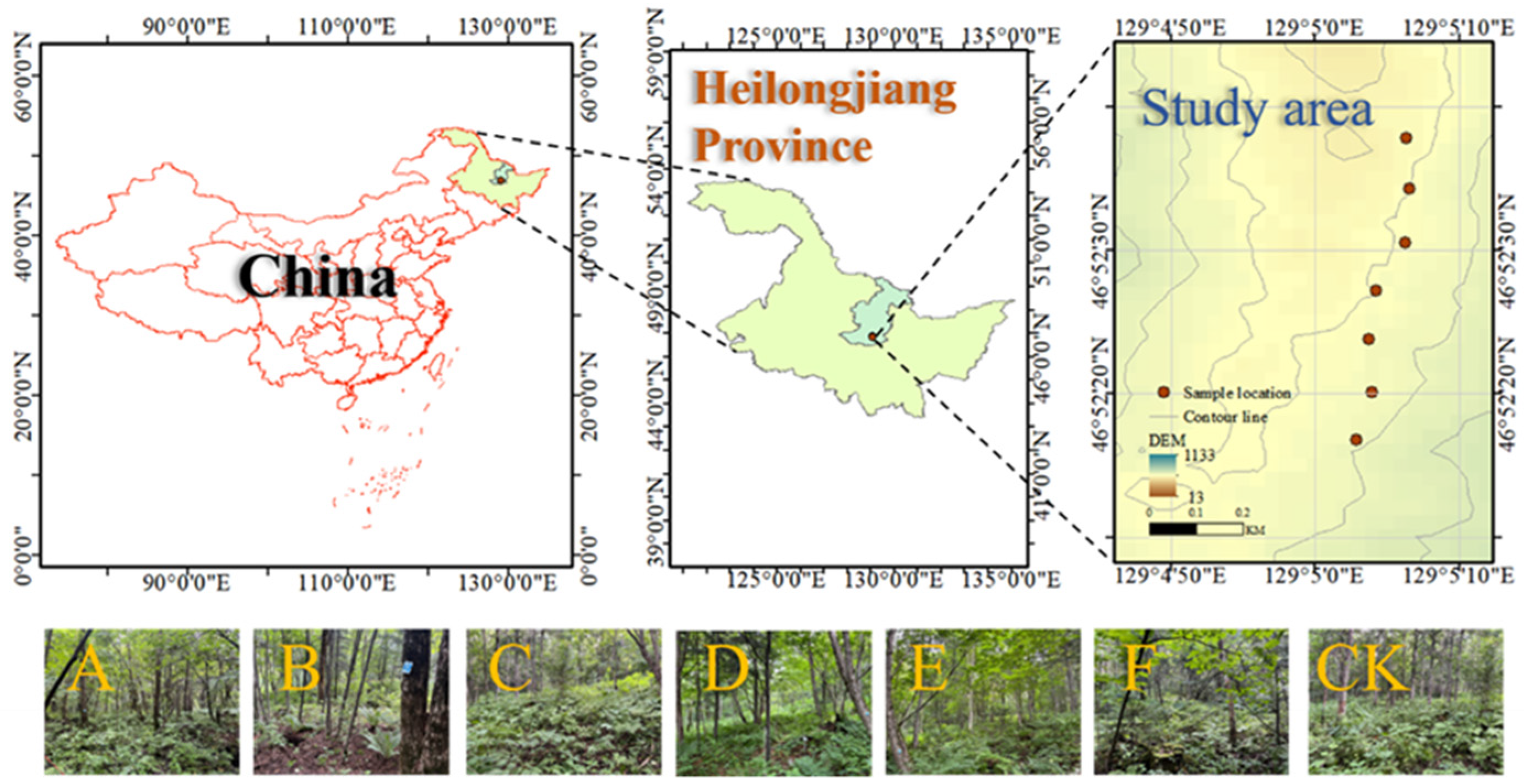
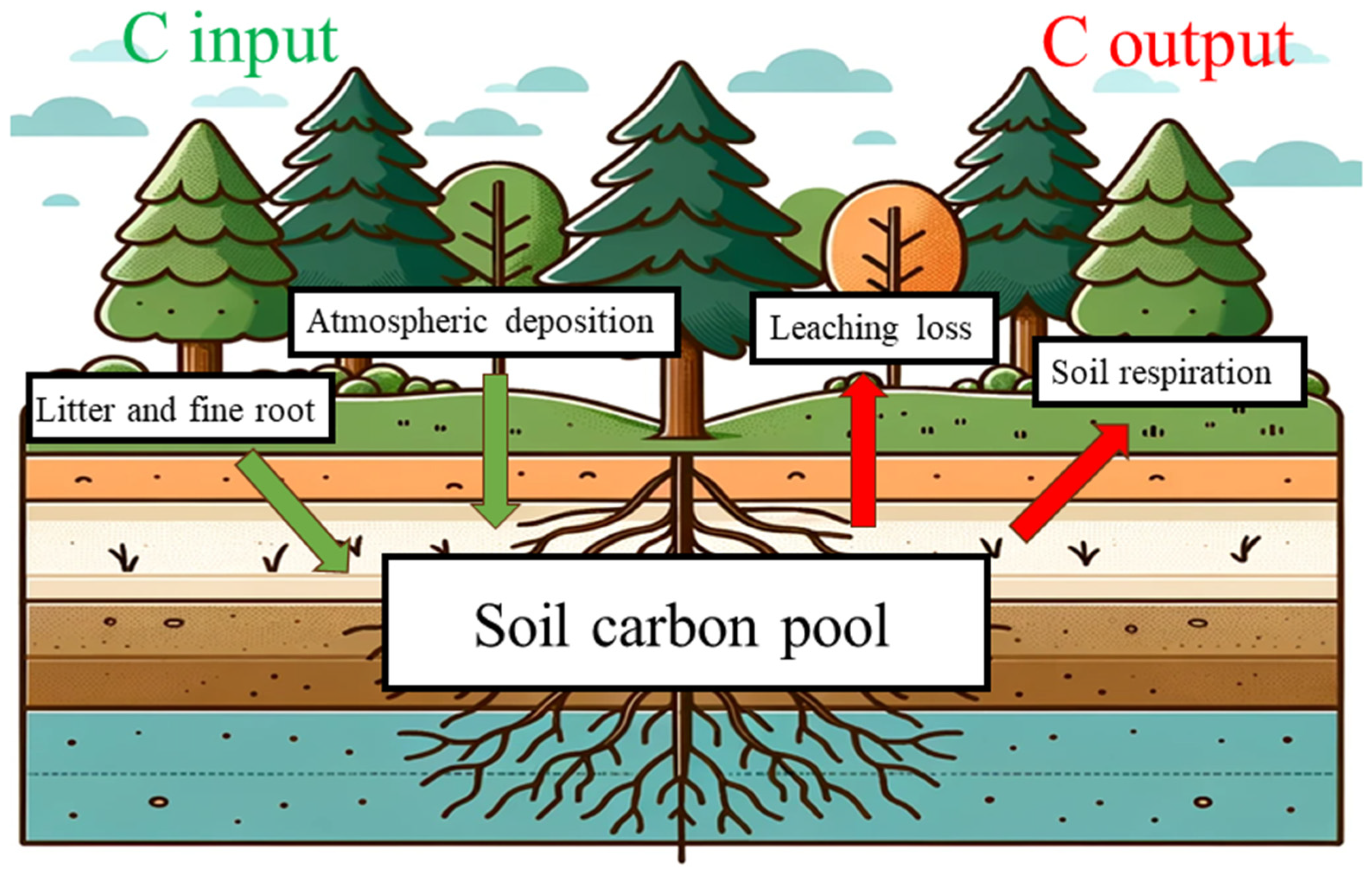
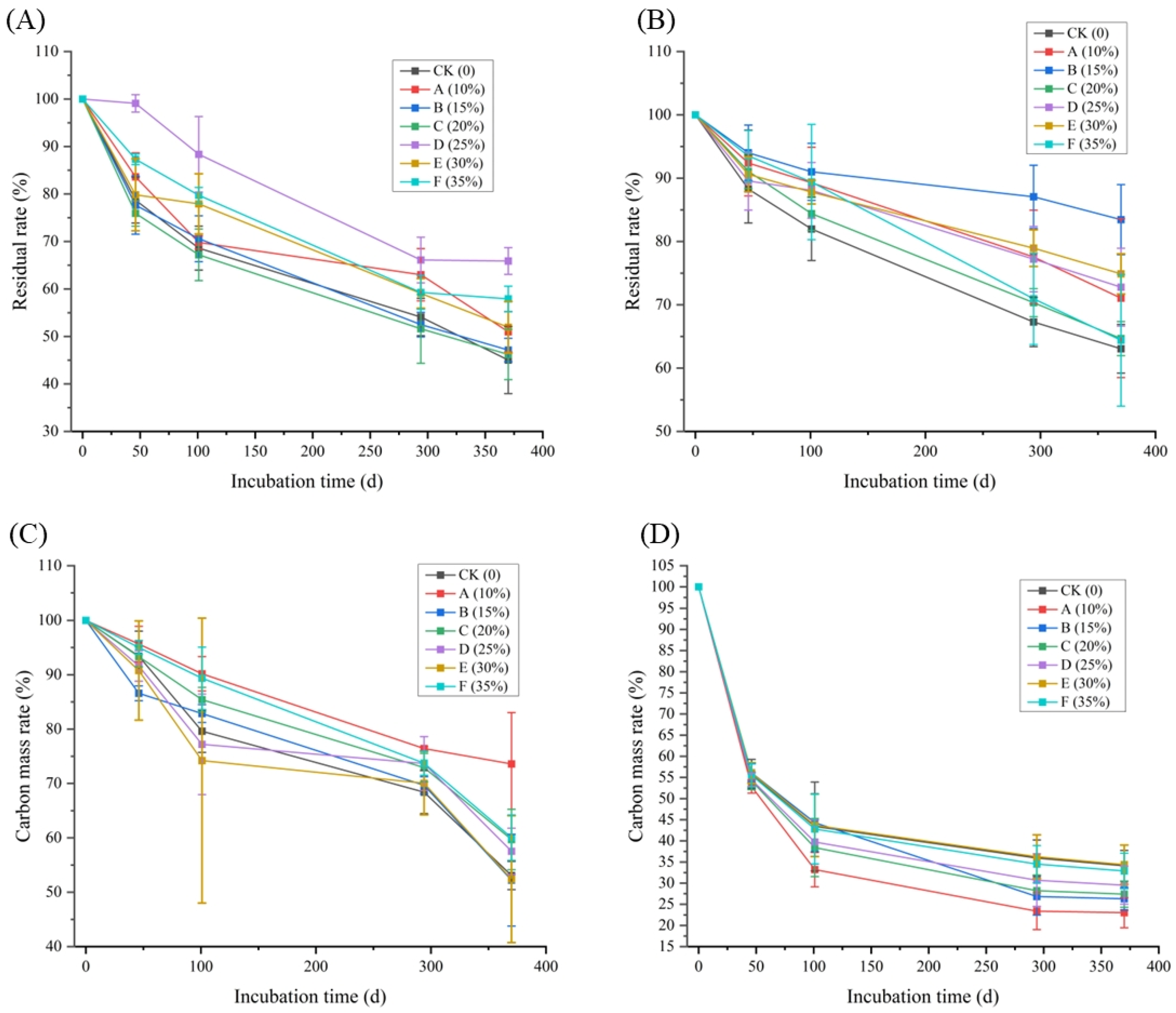
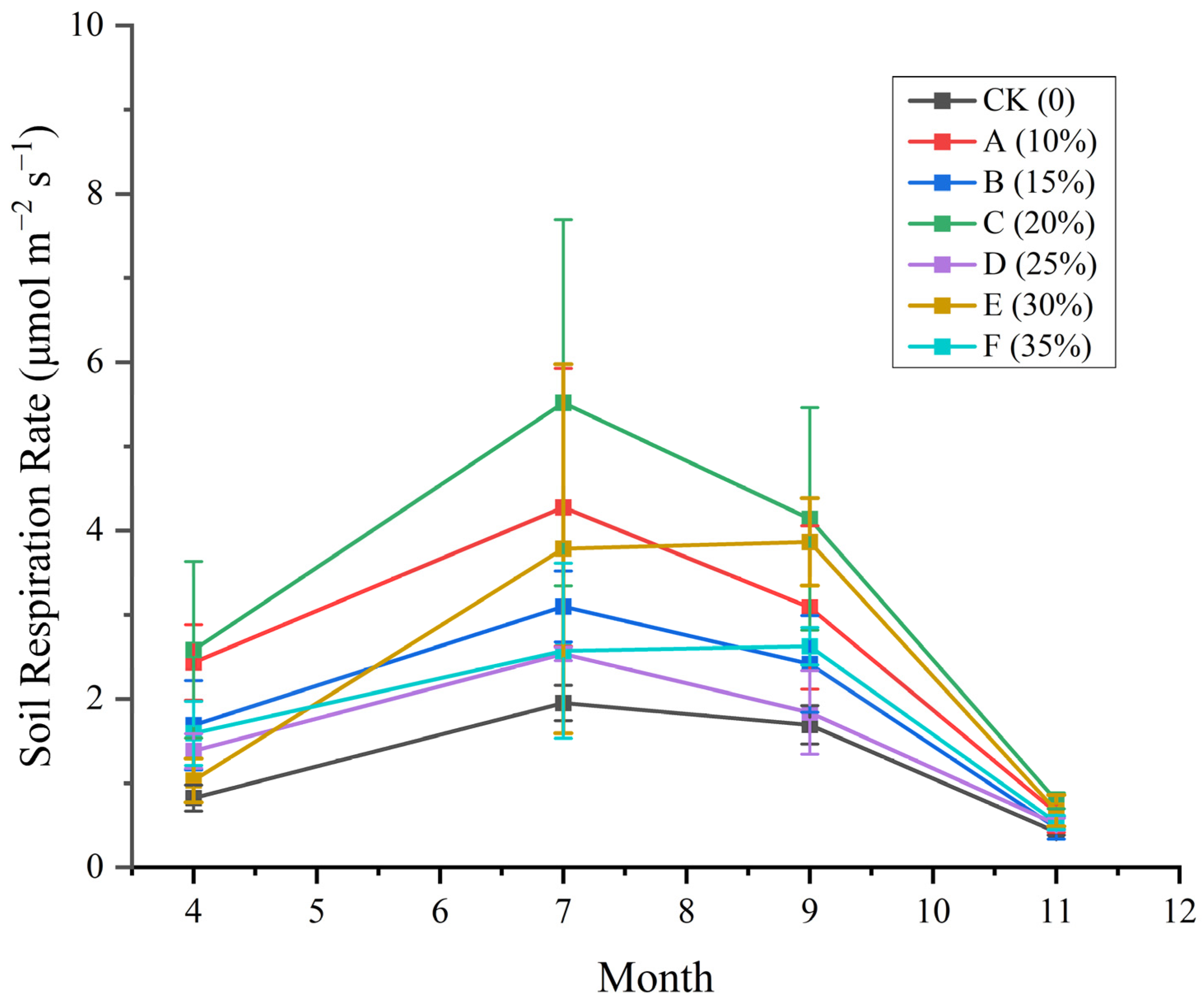
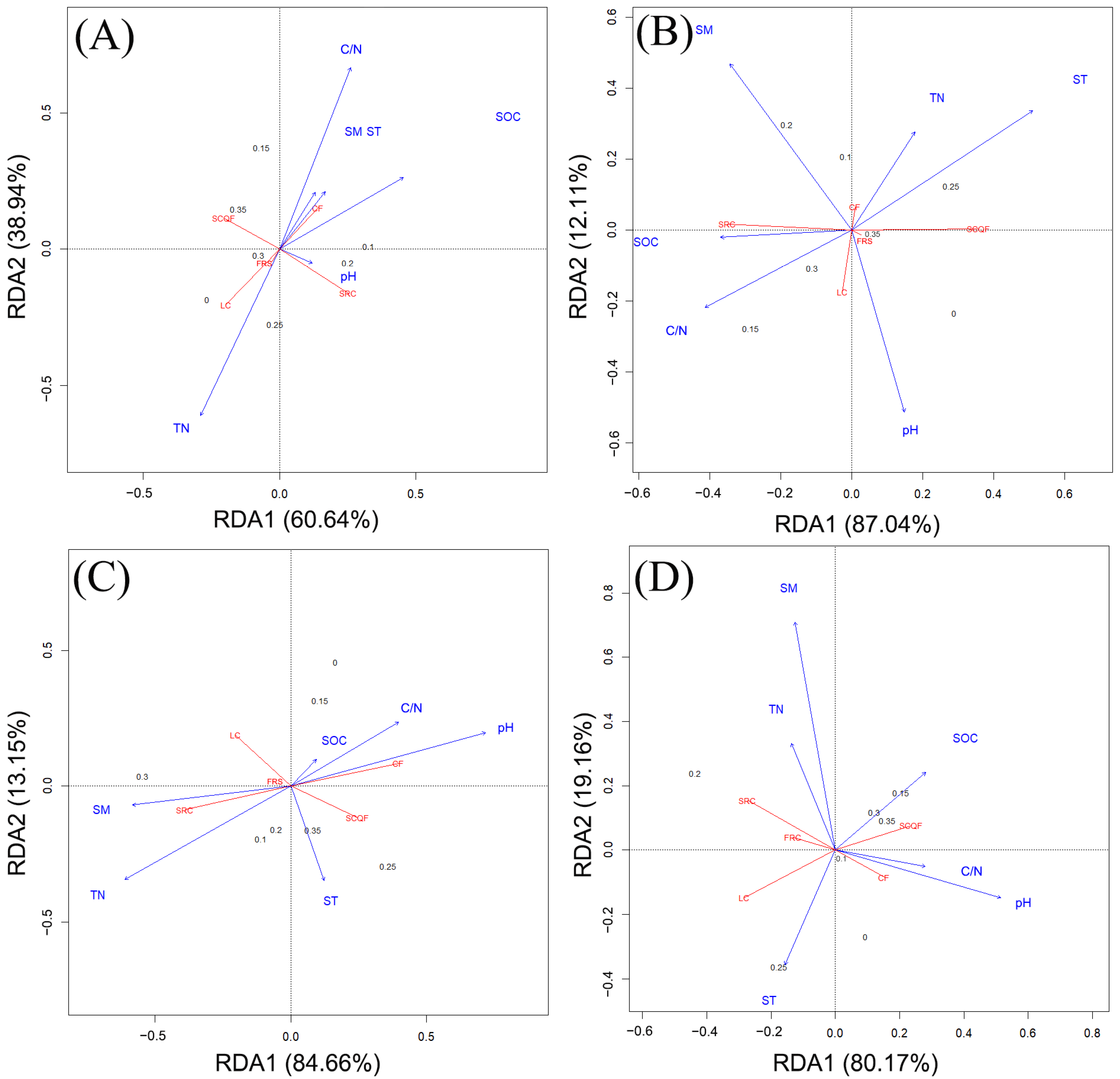
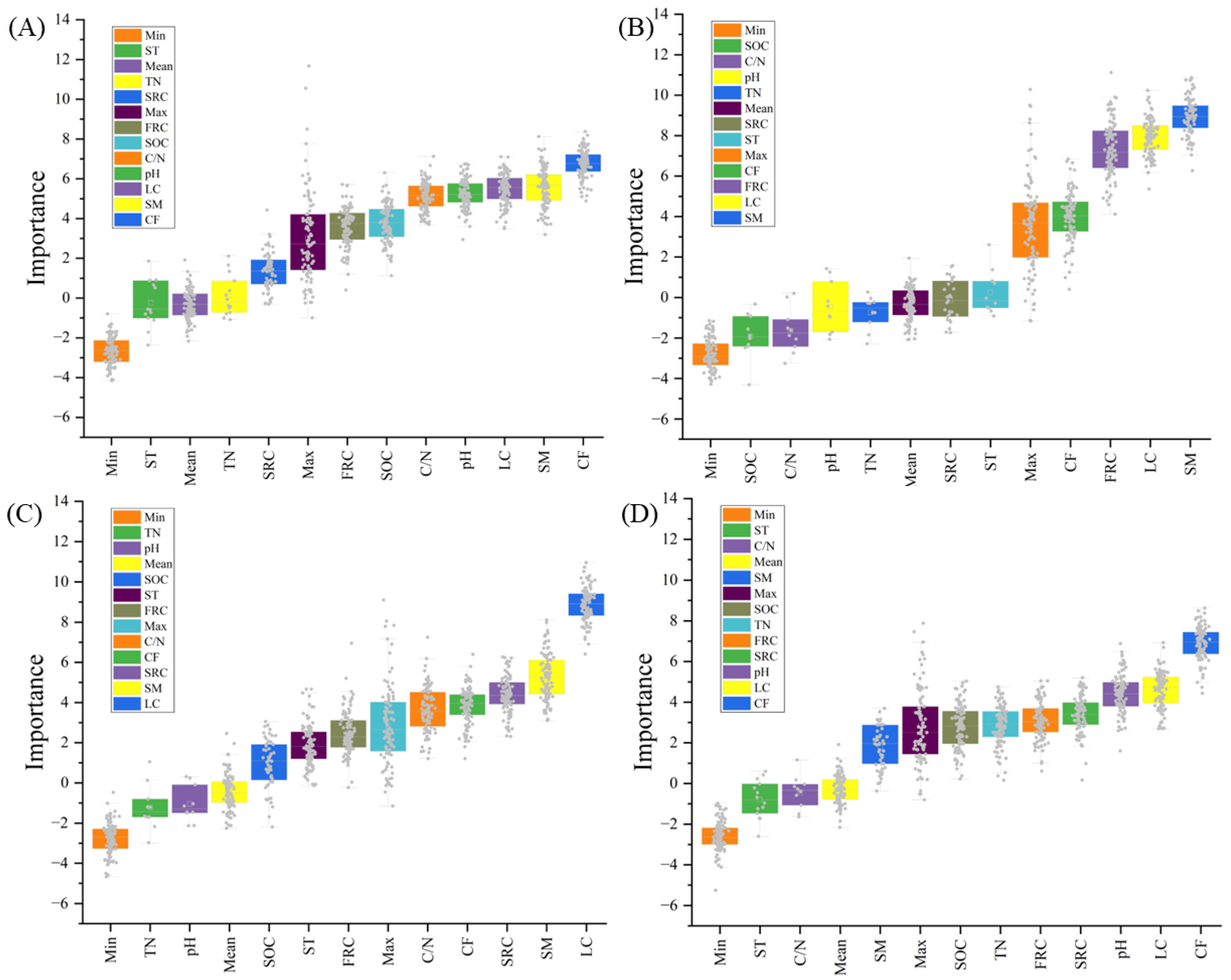
| Thinning Intensity | Mean Diameter at Breast Height (cm) | Mean Tree Height (m) | Stand Density per Hectare (Trees/ha) | Latitude | Longitude |
|---|---|---|---|---|---|
| CK (0) | 11.65 ± 4.92 | 12.14 ± 4.59 | 1456 | 46°52′16.74″ | 129°5′2.89″ |
| A (10%) | 15.36 ± 8.34 | 12.92 ± 4.28 | 967 | 46°52′37.86″ | 129°5′6.35″ |
| B (15%) | 15.00 ± 7.58 | 12.58 ± 4.36 | 1256 | 46°52′34.32″ | 129°5′6.57″ |
| C (20%) | 16.14 ± 7.51 | 11.77 ± 4.81 | 1022 | 46°52′30.53″ | 129°5′6.32″ |
| D (25%) | 14.36 ± 8.19 | 11.14 ± 4.40 | 1189 | 46°52′27.18″ | 129°5′4.26″ |
| E (30%) | 13.38 ± 6.64 | 12.17 ± 4.25 | 1122 | 46°52′23.82″ | 129°5′3.72″ |
| F (35%) | 14.66 ± 7.29 | 13.74 ± 4.87 | 1167 | 46°52′20.10″ | 129°5′3.94″ |
| Season | Index | Thinning Intensity | F | p | ||||||
|---|---|---|---|---|---|---|---|---|---|---|
| CK (0) | A (10%) | B (15%) | C (20%) | D (25%) | E (30%) | F (35%) | ||||
| Spring | pH value | 5.33 ± 1.33 b | 6.04 ± 0.81 ab | 6.33 ± 1.06 ab | 6.48 ± 1.15 ab | 7.34 ± 0.68 a | 6.54 ± 0.47 ab | 6.72 ± 0.15 ab | 1.42 | ns |
| Soil moisture (%) | 24.24 ± 0.45 e | 28.50 ± 2.14 d | 43.86 ± 1.69 a | 33.46 ± 2.66 c | 34.17 ± 0.23 c | 40.67 ± 0.06 b | 18.47 ± 2.25 f | 84.46 | *** | |
| Soil temperature (°C) | 15.08 ± 0.26 b | 15.05 ± 0.44 b | 16.63 ± 0.57 a | 16.93 ± 0.74 a | 16.22 ± 0.94 ab | 15.76 ± 0.93 ab | 15.66 ± 0.51 ab | 3.53 | * | |
| Soil organic carbon (g kg−1) | 23.68 ± 4.09 c | 49.60 ± 0.80 a | 35.76 ± 7.03 b | 33.90 ± 6.65 b | 36.46 ± 5.17 b | 38.76 ± 5.07 b | 43.66 ± 7.79 ab | 6.15 | ** | |
| Total N (g kg−1) | 4.44 ± 0.52 a | 3.32 ± 0.94 ab | 1.79 ± 0.71 b | 2.83 ± 1.19 ab | 3.62 ± 1.47 a | 3.37 ± 0.88 ab | 3.62 ± 0.29 a | 2.31 | ns | |
| C/N | 5.36 ± 0.91 b | 15.85 ± 4.89 ab | 24.22 ± 16.32 a | 12.66 ± 2.50 ab | 11.09 ± 3.88 ab | 12.05 ± 3.24 ab | 12.14 ± 2.72 ab | 2.09 | ns | |
| Summer | pH value | 6.35 ± 0.22 a | 5.63 ± 0.36 a | 6.39 ± 0.06 a | 5.70 ± 1.55 a | 5.92 ± 0.28 a | 5.51 ± 0.18 a | 6.34 ± 0.11 a | 1.105 | ns |
| Soil moisture (%) | 23.22 ± 0.08 g | 39.11 ± 0.71 c | 28.92 ± 0.07 f | 40.57 ± 0.15 b | 34.05 ± 0.45 d | 44.94 ± 0.17 a | 29.68 ± 0.68 e | 989.98 | *** | |
| Soil temperature (°C) | 20.71 ± 0.26 bc | 21.24 ± 0.23 ab | 19.90 ± 0.22 d | 20.28 ± 0.09 cd | 21.59 ± 0.61 a | 18.96 ± 0.47 e | 21.11 ± 0.34 ab | 19.63 | *** | |
| Soil organic carbon (g kg−1) | 37.73 ± 18.80 a | 46.40 ± 22.92 a | 59.08 ± 43.88 a | 58.65 ± 17.40 a | 56.15 ± 42.89 a | 84.46 ± 24.62 a | 33.46 ± 16.61 a | 1.035 | ns | |
| Total N (g kg−1) | 5.39 ± 0.28 cd | 5.80 ± 0.61 cd | 6.87 ± 0.39 b | 7.33 ± 0.28 b | 10.28 ± 0.60 a | 5.93 ± 0.52 c | 5.07 ± 0.31 d | 47.58 | *** | |
| C/N | 7.11 ± 3.77 ab | 7.91 ± 3.40 ab | 8.85 ± 6.97 ab | 7.98 ± 2.20 ab | 5.63 ± 4.59 b | 14.25 ± 3.85 a | 6.72 ± 3.50 ab | 1.29 | ns | |
| Autumn | pH value | 6.74 ± 0.55 a | 5.84 ± 0.88 ab | 6.65 ± 0.53 a | 6.27 ± 0.47 a | 6.47 ± 0.24 a | 5.16 ± 0.69 b | 6.74 ± 0.44 a | 3.12 | * |
| Soil moisture (%) | 20.11 ± 0.63 e | 35.75 ± 0.08 b | 30.67 ± 2.64 c | 34.21 ± 0.25 d | 24.14 ± 0.31 d | 40.60 ± 0.10 a | 14.00 ± 0.20 f | 247.17 | *** | |
| Soil temperature (°C) | 15.38 ± 0.27 bc | 17.61 ± 0.27 a | 16.33 ± 0.69 b | 16.41 ± 0.84 b | 15.99 ± 0.84 bc | 15.13 ± 0.30 c | 16.03 ± 0.18 bc | 6.37 | ** | |
| Soil organic carbon (g kg−1) | 43.50 ± 1.62 a | 31.35 ± 0.51 c | 36.04 ± 7.36 bc | 40.11 ± 4.45 ab | 41.80 ± 2.73 ab | 42.09 ± 0.36 ab | 43.76 ± 2.53 a | 4.78 | ** | |
| Total N (g kg−1) | 5.22 ± 0.19 c | 6.38 ± 0.14 a | 5.11 ± 0.74 c | 5.55 ± 0.26 bc | 5.37 ± 0.54 c | 6.23 ± 0.19 ab | 5.45 ± 0.33 c | 4.68 | ** | |
| C/N | 8.34 ± 0.03 a | 4.91 ± 0.03 c | 7.04 ± 1.08 ab | 7.24 ± 0.95 ab | 7.84 ± 0.94 ab | 6.76 ± 0.19 b | 8.03 ± 0.49 ab | 8.51 | ** | |
| Winter | pH value | 6.23 ± 0.41 ab | 6.48 ± 0.10 a | 6.08 ± 0.56 ab | 5.52 ± 0.79 b | 5.73 ± 0.45 ab | 5.77 ± 0.20 ab | 6.05 ± 0.07 ab | 1.65 | ns |
| Soil moisture (%) | 27.66 ± 0.54 d | 34.30 ± 0.36 c | 38.70 ± 0.12 bc | 44.44 ± 0.27 ab | 27.03 ± 0.06 d | 44.99 ± 3.16 a | 34.4 ± 8.06 c | 14.59 | *** | |
| Soil temperature (°C) | 4.02 ± 0.60 bc | 6.42 ± 0.33 a | 4.87 ± 0.68 b | 4.25 ± 0.79 bc | 6.52 ± 0.23 a | 3.74 ± 0.15 c | 4.05 ± 0.68 bc | 13.61 | *** | |
| Soil organic carbon (g kg−1) | 27.13 ± 14.97 b | 27.41 ± 6.82 b | 47.54 ± 14.69 ab | 31.93 ± 15.04 b | 40.55 ± 2.52 b | 62.92 ± 11.82 a | 40.27 ± 11.35 b | 3.44 | * | |
| Total N (g kg−1) | 2.63 ± 1.37 b | 2.17 ± 0.81 b | 4.13 ± 2.60 ab | 5.23 ± 2.14 ab | 3.90 ± 2.52 ab | 3.33 ± 1.37 ab | 6.53 ± 1.80 a | 1.88 | ns | |
| C/N | 10.47 ± 2.22 a | 13.33 ± 3.23 a | 17.23 ± 13.77 a | 6.15 ± 2.17 a | 17.15 ± 16.31 a | 27.28 ± 8.94 a | 6.44 ± 2.47 a | 1.25 | ns | |
| Thinning Intensity | Regression Equation | Correlation Coefficient (R2) | Decomposition Constant k | t0.5/a | t0.95/a |
|---|---|---|---|---|---|
| CK (0) | y = 0.9221 e−0.7381t | 0.9219 | 0.7381 a | 0.94 | 4.06 |
| A (10%) | y = 0.9287 e−0.5875t | 0.8831 | 0.5875 cd | 1.18 | 5.10 |
| B (15%) | y = 0.9210 e−0.7219t | 0.9238 | 0.7219 ab | 0.96 | 4.15 |
| C (20%) | y = 0.9078 e−0.7401t | 0.8961 | 0.7401 a | 0.94 | 4.05 |
| D (25%) | y = 1.0165 e−0.4704t | 0.9702 | 0.4704 d | 1.47 | 6.37 |
| E (30%) | y = 0.9363 e−0.5991t | 0.9346 | 0.5991 bc | 1.16 | 5.00 |
| F (35%) | y = 0.9618 e−0.5595t | 0.9678 | 0.5595 cd | 1.24 | 5.35 |
| Thinning Intensity | Regression Equation | Correlation Coefficient (R2) | Decomposition Constant k | t0.5/a | t0.95/a |
|---|---|---|---|---|---|
| CK (0) | y = 0.9598 e−0.4403t | 0.9629 | 0.4403 a | 1.57 | 6.80 |
| A (10%) | y = 0.9810 e−0.3115t | 0.9824 | 0.3115 abc | 2.22 | 9.62 |
| B (15%) | y = 0.9733 e−0.1529t | 0.9043 | 0.1529 d | 4.53 | 19.60 |
| C (20%) | y = 0.9738 e−0.4140t | 0.9819 | 0.4140 ab | 1.67 | 7.24 |
| D (25%) | y = 0.9643 e−0.2841t | 0.9429 | 0.2841 bc | 2.44 | 10.54 |
| E (30%) | y = 0.9642 e−0.2574t | 0.9364 | 0.2574 cd | 2.69 | 11.64 |
| F (35%) | y = 0.9972 e−0.4267t | 0.9981 | 0.4267 a | 1.62 | 7.02 |
| Season | Thinning Intensity | Litter Carbon Input (t/hm2) | Fine Root Carbon Input (t/hm2) | Soil Respiration Carbon Output (t/hm2) | Correction Factor ε (t/hm2) | Soil Carbon Quarterly Fixed Value (t/hm2) |
|---|---|---|---|---|---|---|
| Spring | CK (0) | 1.14 | 0.12 | 0.77 | 1.33 | 1.81 |
| A (10%) | 0.87 | 0.12 | 2.27 | 3.45 | 2.17 | |
| B (15%) | 1.30 | 0.18 | 1.58 | 5.05 | 4.95 | |
| C (20%) | 1.15 | 0.14 | 2.41 | 3.59 | 2.47 | |
| D (25%) | 1.16 | 0.13 | 1.29 | 1.69 | 1.69 | |
| E (30%) | 0.94 | 0.10 | 0.97 | 1.83 | 1.90 | |
| F (35%) | 1.69 | 0.15 | 1.49 | 3.81 | 4.16 | |
| Summer | CK (0) | 0.85 | 0.03 | 1.82 | 4.70 | 3.75 |
| A (10%) | 0.63 | 0.02 | 3.99 | 6.66 | 3.31 | |
| B (15%) | 0.71 | 0.01 | 2.89 | 3.27 | 1.10 | |
| C (20%) | 0.59 | 0.02 | 5.15 | 7.15 | 2.61 | |
| D (25%) | 0.64 | 0.03 | 2.37 | 6.35 | 4.65 | |
| E (30%) | 0.81 | 0.03 | 3.54 | 4.96 | 2.26 | |
| F (35%) | 0.55 | 0.04 | 2.40 | 4.08 | 2.26 | |
| Autumn | CK (0) | 1.71 | 0.55 | 1.58 | −3.39 | −2.71 |
| A (10%) | 1.18 | 0.54 | 2.88 | −1.58 | −2.73 | |
| B (15%) | 1.94 | 0.51 | 2.26 | −3.53 | −3.34 | |
| C (20%) | 1.70 | 0.57 | 3.87 | −2.56 | −4.15 | |
| D (25%) | 0.55 | 0.61 | 1.72 | −4.21 | −4.78 | |
| E (30%) | 1.57 | 0.50 | 3.61 | 0.51 | −1.03 | |
| F (35%) | 1.04 | 0.54 | 2.45 | −2.56 | −3.43 | |
| Winter | CK (0) | 1.22 | 0.15 | 0.39 | −3.83 | −2.85 |
| A (10%) | 1.01 | 0.20 | 0.61 | −3.36 | −2.75 | |
| B (15%) | 0.52 | 0.13 | 0.44 | −2.92 | −2.71 | |
| C (20%) | 0.79 | 0.19 | 0.74 | −1.17 | −0.93 | |
| D (25%) | 1.34 | 0.16 | 0.48 | −2.58 | −1.56 | |
| E (30%) | 0.83 | 0.13 | 0.63 | −3.46 | −3.13 | |
| F (35%) | 0.72 | 0.16 | 0.50 | −3.37 | −2.99 |
Disclaimer/Publisher’s Note: The statements, opinions and data contained in all publications are solely those of the individual author(s) and contributor(s) and not of MDPI and/or the editor(s). MDPI and/or the editor(s) disclaim responsibility for any injury to people or property resulting from any ideas, methods, instructions or products referred to in the content. |
© 2024 by the authors. Licensee MDPI, Basel, Switzerland. This article is an open access article distributed under the terms and conditions of the Creative Commons Attribution (CC BY) license (https://creativecommons.org/licenses/by/4.0/).
Share and Cite
Zhang, B.; Gao, R.; Dong, X. The Seasonal Impact of Thinning Intensities on Soil Carbon Cycling in the Lesser Xing’an Range, Northeast China. Forests 2024, 15, 449. https://doi.org/10.3390/f15030449
Zhang B, Gao R, Dong X. The Seasonal Impact of Thinning Intensities on Soil Carbon Cycling in the Lesser Xing’an Range, Northeast China. Forests. 2024; 15(3):449. https://doi.org/10.3390/f15030449
Chicago/Turabian StyleZhang, Baoshan, Ran Gao, and Xibin Dong. 2024. "The Seasonal Impact of Thinning Intensities on Soil Carbon Cycling in the Lesser Xing’an Range, Northeast China" Forests 15, no. 3: 449. https://doi.org/10.3390/f15030449
APA StyleZhang, B., Gao, R., & Dong, X. (2024). The Seasonal Impact of Thinning Intensities on Soil Carbon Cycling in the Lesser Xing’an Range, Northeast China. Forests, 15(3), 449. https://doi.org/10.3390/f15030449






